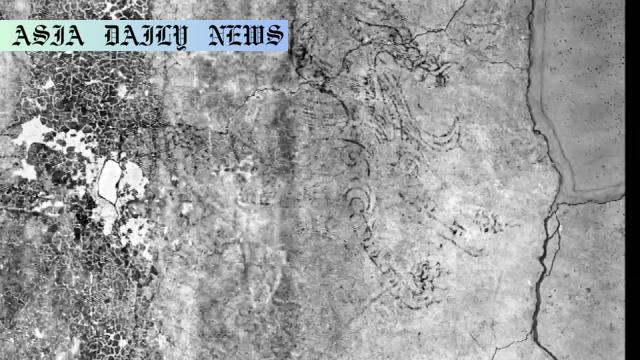Infrared photography sharpens the image of the Azure Dragon mural at Kitora Tumulus, showcasing its unique details.
Infrared photography enhances the Azure Dragon mural’s image in Japan’s Kitora Tumulus.
The Cultural Affairs Agency has revealed the dragon’s head, forefoot, and intricate scales using cutting-edge technology.
Further photographic methods will be applied to uncover parts still obscured by mud.

Introduction to Infrared Photography at Kitora Tumulus
The ancient Kitora Tumulus, located in the village of Asuka in Japan’s Nara Prefecture, has become a focal point for technological innovation in art preservation. Using high-performance infrared photography, Japan’s Agency for Cultural Affairs has achieved a breakthrough in visualizing the mural of the Azure Dragon, a depiction of one of the four directional deities. This mural is part of a stone chamber designated as a national treasure and holds immense cultural and historical significance.
The Mysterious Azure Dragon Mural
Over centuries, the mural depicting the Azure Dragon has been obscured by layers of mud and debris. Previously, only parts of its head and forefoot were visible, creating an incomplete picture of the legendary creature. The dragon is depicted on the eastern wall of the tumulus, but the inability to view its full figure has hindered efforts to fully appreciate its artistic majesty. Thanks to the application of cutting-edge infrared photography, this barrier is now being broken.
The Role of Technology in Restoration
Infrared technology plays a transformative role in heritage restoration. By photographing the painting and processing the images obtained, researchers are revealing intricate details of the dragon’s body. The images now clearly show its elongated body, scales running along its back, and even details previously concealed by mud. Although the tail and hind feet remain blurry, the overall image of the Azure Dragon provides deeper insights into artistic techniques from that era. This advancement underscores the importance of utilizing technology in the preservation of cultural treasures.
Future Plans for Examination
While the recent achievement is a significant step, there is more to uncover. The Cultural Affairs Agency plans to employ additional photographic techniques to further analyze the mural. It aims to examine the parts still hidden under debris for a more comprehensive restoration. Officials have also announced plans to display the enhanced images, enabling the public to appreciate the murals in greater detail when they are eventually opened for public exhibition.
The Significance of the Azure Dragon
In ancient East Asian cosmology, the Azure Dragon represents the eastern direction and the spring season, symbolizing power, strength, and protection. Its presence in the Kitora Tumulus mural speaks volumes about the spiritual and cultural aspirations of the time. Restoring such imagery not only preserves history but also deepens our understanding of ancient Japanese beliefs and their artistic representations. The unveiling of the dragon’s full shape may shed new light on interpretation, historical context, and the artist’s original intent.
Collaborative Efforts and Academic Insights
Emeritus Professor Wada Seigo of Ritsumeikan University leads the study group dedicated to this initiative. He has lauded the recent advancements, calling the revelation of the dragon’s shape a monumental achievement in the restoration of the mural. The collaboration between technology experts, cultural preservationists, and academics highlights a unified effort to conserve such treasures, serving as a model for future heritage preservation projects.
Conclusion
The Kitora Tumulus revelation marks a significant chapter in the use of technology for cultural heritage. Infrared photography’s success demonstrates its potential for uncovering lost details and amplifying our awareness of ancient artistry. Future efforts to examine the mural further will continue to bridge the gap between past and present, ensuring that the legacy of the Kitora murals endures for generations to come.



Commentary
The Intersection of Technology and Heritage Preservation
The advancements achieved in revealing the Azure Dragon mural showcase the remarkable intersection of technology and heritage preservation. Infrared imaging has once again proven to be an invaluable tool in archaeology and art restoration, allowing us to peer beneath layers of mud and debris to uncover ancient masterpieces long thought lost to time. This technology is not just about imaging; it’s an act of reviving history and bringing it closer to the modern audience.
The Cultural Weight of the Azure Dragon
The Azure Dragon encapsulates ancient symbolism that carries both artistic and cultural weight. Its association with seasonal cycles, protection, and directional elements enriches our understanding of how the people of the past connected to their environment and imbued their beliefs into their art. Restoring this mural offers a window into such profound cultural expressions, urging us to not only marvel at its artistic beauty but also reflect on the meaning it held for the people who created it.
Technology as a Bridge to the Past
What excites me most about this breakthrough is how it sets a precedent for using advanced technologies to recover lost histories. From infrared photography to future imaging techniques, such tools have the power to reintroduce us to forgotten parts of human civilization. This accomplishment in Asuka’s Kitora Tumulus may inspire further projects that revive art and stories hidden in the shadows of time.
Overall, this initiative is a reminder of how innovation and tradition can coexist, opening up pathways to keep history alive and accessible. By continuing this work, we uphold the importance of global heritage while embracing the possibilities of modern science.